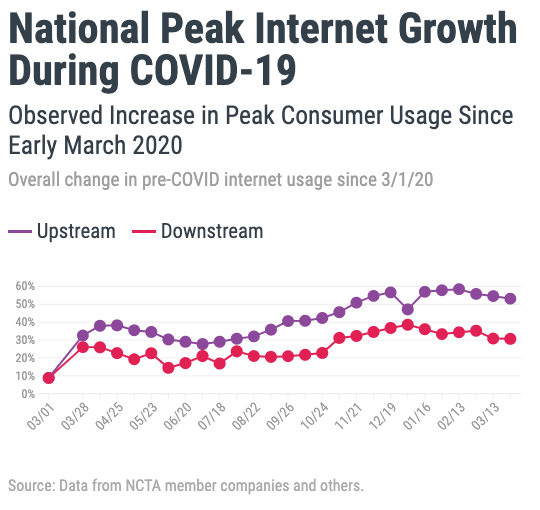It's been more than a year now since COVID-19 forced Americans into lockdown and sent many of them straight to their homes to continue their lives online. In their reflections on the one-year anniversary of COVID, chief technology officers from America's leading internet service providers concurred that the ability of their networks to perform so well over the past 12 months, despite significant surges in internet traffic, comes down to several factors. Those include years of investment, planning and looking ahead, combined with the incredible hard work of their employees to accelerate network expansion and ensure that as many people as possible could continue working, learning and connecting online. In agreement with these points, NCTA Chief Technology Officer and Senior Vice President of Technology Bill Check and NCTA Vice President of Broadband Technology Matt Tooley offered their own observations they gleaned from working on the NCTA COVID-19 Dashboard over the past year. The dashboard tool launched in March 2020 and is updated on a biweekly basis with data from network performance reports submitted by cable operators.
One of the important pieces to acknowledge in this, said Check, is that despite it being an unprecedented time, cable operators continued to build out their networks in order to be able to handle the increased capacity and keep their networks running smoothly. "As you can see in the dashboard graph, in spite of it going up, the utilization is staying the same. This means that cable operators have had to add capacity to keep the utilization from increasing as the capacity has gone up," explained Check.

Tooley also remarked, "The pandemic is appearing to be a step function in the traffic. Traffic went up 30% more than it would have in any other normal year, and continued to grow at the yearly rate from that new base, and that is what you see on the charts." In other words, this is an internet usage trend that started from the onset of the pandemic and has stuck around. Cable networks constantly experience growth in any given year. The dashboard charts reflect that growth plus the additional "COVID load" on top of that.
Over the course of the year, cable networks saw consumers dive even more so into video streaming, which grew by 70%. Although video conferencing usage increased due to remote work, even experiencing up to 700% growth on select networks, this usage still only accounted for 5% of total traffic on cable networks. As this NCTA piece explains, residential broadband traffic has always been asymmetric because downstream traffic continues to dominate total traffic. The data from NCTA member companies reveal that downstream-to-upstream traffic has only slightly changed during the pandemic. As of December 2020, the downstream-to-upstream traffic ratio increased to 16:1 from 14:1 in early 2019. "Asymmetric traffic is continuing to grow now that we've crossed that step function," added Tooley.
But with the rise in usage for video conferencing as a result of the pandemic, CableLabs set out to measure how many concurrent sessions could be done over a cable connection. The results showed that six sessions could be conducted on a 25 Mbps downstream /3 Mbps upstream speed connection, and 10 sessions could be conducted on a 50/5 speed connection perfectly fine with no hiccups or defects. Notably, the results indicated that 25/3 and 50/5 speed connections are more than sufficient to support video conferencing demands as well as other video streaming and browsing applications at the same time. "But this just goes to show that overall, the mix of applications continue to be downstream-intensive applications and not upstream-intensive applications," said Tooley.
Another lesson learned over the past year has been that in many cases connectivity issues experienced by consumers didn't have anything to do with internet speeds or the service itself. "Those with outdated home network equipment just needed to upgrade in a lot of those cases," said Tooley. As the speed tests conducted by CableLabs found, and as NCTA's paper 'Tele-Everything and Its Impact to the Network' discusses, the incredible traffic growth last year—especially during the first month of the pandemic when cable networks experienced six months to a year's worth of traffic growth in one month—did not have any measurable impact on download or upload speeds.
Cable operators continue to stay out front to ensure a robust and fast internet connection experience for consumers during a time when remote work and virtual learning have become the norm. Time will tell how behaviors may change after the pandemic, but ISPs are prepared for the unknown, as this past year has revealed.
Check back for more observations and updates on network performance in the weeks to come.
